简介
前言
一、基础知识篇
1.1 CTF 简介
1.2 学习方法
1.3 Linux 基础
1.4 Web 安全基础
1.4.1 HTML 基础
1.4.2 HTTP 协议基础
1.4.3 JavaScript 基础
1.4.4 常见 Web 服务器基础
1.4.5 OWASP Top Ten Project 漏洞基础
1.4.6 PHP 源码审计基础
1.5 逆向工程基础
1.5.1 C/C++ 语言基础
1.5.2 汇编基础
1.5.3 Linux ELF
1.5.4 Windows PE
1.5.5 静态链接
1.5.6 动态链接
1.5.7 内存管理
1.5.8 glibc malloc
1.5.9 Linux 内核
1.5.10 Windows 内核
1.5.11 jemalloc
1.6 密码学基础
1.6.1 密码学导论
1.6.2 流密码
1.6.3 分组密码
1.6.4 公钥密码
1.6.5 消息认证和哈希函数
1.6.6 数字签名
1.6.7 密码协议
1.6.8 密钥分配与管理
1.6.9 数字货币
1.7 Android 安全基础
1.7.1 Android 环境搭建
1.7.2 Dalvik 指令集
1.7.3 ARM 汇编基础
1.7.4 Android 常用工具
2.1.1 VirtualBox
2.1.2 QEMU
2.1.3 Docker
2.1.4 Unicorn
2.2.1 radare2
2.2.2 IDA Pro
2.2.3 JEB
2.2.4 Capstone
2.2.5 Keystone
2.3.1 GDB
2.3.2 OllyDbg
2.3.3 x64dbg
2.3.4 WinDbg
2.3.5 LLDB
2.4.1 pwntools
2.4.2 zio
2.4.3 metasploit
2.4.4 binwalk
2.4.5 Burp Suite
2.4.6 Wireshark
2.4.7 Cuckoo Sandbox
3.1.1 格式化字符串漏洞
3.1.2 整数溢出
3.1.3 栈溢出
3.1.4 返回导向编程(ROP)(x86)
3.1.5 返回导向编程(ROP)(ARM)
3.1.6 Linux 堆利用(一)
3.1.7 Linux 堆利用(二)
3.1.8 Linux 堆利用(三)
3.1.9 Linux 堆利用(四)
3.1.10 内核 ROP
3.1.11 Linux 内核漏洞利用
3.1.12 Windows 内核漏洞利用
3.1.13 竞争条件
3.1.14 虚拟机逃逸
3.2.1 patch 二进制文件
3.2.2 脱壳技术(PE)
3.2.3 脱壳技术(ELF)
3.2.4 反调试技术(PE)
3.2.5 反调试技术(ELF)
3.2.6 指令混淆
3.3.1 SQL 注入利用
3.3.2 XSS 漏洞利用
二、工具篇
三、分类专题篇
四、技巧篇
4.1 Linux 内核调试
4.2 Linux 命令行技巧
4.3 GCC 编译参数解析
4.4 GCC 堆栈保护技术
4.5 ROP 防御技术
4.6 one-gadget RCE
4.7 通用 gadget
4.8 使用 DynELF 泄露函数地址
4.9 shellcode 开发
4.10 跳转导向编程(JOP)
4.12 利用 __stack_chk_fail
4.13 利用 _IO_FILE 结构
4.14 glibc tcache 机制
4.15 利用 vsyscall 和 vDSO
五、高级篇
5.0 软件漏洞分析
5.1 模糊测试
5.1.1 AFL fuzzer
5.1.2 libFuzzer
5.2 动态二进制插桩
5.2.1 Pin
5.2.2 DynamoRio
5.2.3 Valgrind
5.3 符号执行
5.3.1 angr
5.3.2 Triton
5.3.3 KLEE
5.3.4 S²E
5.4 数据流分析
5.4.1 Soot
5.5 污点分析
5.5.1 TaintCheck
5.6 LLVM
5.6.1 Clang
5.7 程序切片
5.8 SAT/SMT
5.8.1 Z3
5.9 基于模式的漏洞分析
5.10 基于二进制比对的漏洞分析
5.11 反编译技术
5.11.1 RetDec
6.1.1 pwn HCTF2016 brop
6.1.2 pwn NJCTF2017 pingme
6.1.3 pwn XDCTF2015 pwn200
6.1.4 pwn BackdoorCTF2017 Fun-Signals
6.1.5 pwn GreHackCTF2017 beerfighter
6.1.6 pwn DefconCTF2015 fuckup
6.1.7 pwn 0CTF2015 freenote
6.1.8 pwn DCTF2017 Flex
6.1.9 pwn RHme3 Exploitation
6.1.10 pwn 0CTF2017 BabyHeap2017
6.1.11 pwn 9447CTF2015 Search-Engine
6.1.12 pwn N1CTF2018 vote
6.1.13 pwn 34C3CTF2017 readme_revenge
6.1.14 pwn 32C3CTF2015 readme
6.1.15 pwn 34C3CTF2017 SimpleGC
6.1.16 pwn HITBCTF2017 1000levels
6.1.17 pwn SECCONCTF2016 jmper
6.1.18 pwn HITBCTF2017 Sentosa
6.1.19 pwn HITBCTF2018 gundam
6.1.20 pwn 33C3CTF2016 babyfengshui
6.1.21 pwn HITCONCTF2016 Secret_Holder
6.1.22 pwn HITCONCTF2016 Sleepy_Holder
6.1.23 pwn BCTF2016 bcloud
6.1.24 pwn HITCONCTF2016 House_of_Orange
6.1.25 pwn HCTF2017 babyprintf
6.1.26 pwn 34C3CTF2017 300
6.1.27 pwn SECCONCTF2016 tinypad
6.1.28 pwn ASISCTF2016 b00ks
6.1.29 pwn Insomni'hack_teaserCTF2017 The_Great_Escape_part-3
6.1.30 pwn HITCONCTF2017 Ghost_in_the_heap
6.1.31 pwn HITBCTF2018 mutepig
6.1.32 pwn SECCONCTF2017 vm_no_fun
6.1.33 pwn 34C3CTF2017 LFA
6.1.34 pwn N1CTF2018 memsafety
6.1.35 pwn 0CTF2018 heapstorm2
6.2.1 re XHPCTF2017 dont_panic
6.2.2 re ECTF2016 tayy
6.2.3 re CodegateCTF2017 angrybird
6.2.4 re CSAWCTF2015 wyvern
6.2.5 re PicoCTF2014 Baleful
6.2.6 re SECCONCTF2017 printf_machine
6.2.7 re CodegateCTF2018 RedVelvet
6.2.8 re DefcampCTF2015 entry_language
6.3.1 web HCTF2017 babycrack
7.1.1 CVE-2017-11543 tcpdump sliplink_print 栈溢出漏洞
7.1.2 CVE-2015-0235 glibc __nss_hostname_digits_dots 堆溢出漏洞
7.1.3 CVE-2016-4971 wget 任意文件上传漏洞
7.1.4 CVE-2017-13089 wget skip_short_body 栈溢出漏洞
7.1.5 CVE–2018-1000001 glibc realpath 缓冲区下溢漏洞
7.1.6 CVE-2017-9430 DNSTracer 栈溢出漏洞
7.1.7 CVE-2018-6323 GNU binutils elf_object_p 整型溢出漏洞
7.1.8 CVE-2010-2883 Adobe CoolType SING 表栈溢出漏洞
7.1.9 CVE-2010-3333 Microsoft Word RTF pFragments 栈溢出漏洞
六、题解篇
七、实战篇
八、学术篇
8.1 The Geometry of Innocent Flesh on the Bone: Return-into-libc without Function Calls (on the x86)
8.2 Return-Oriented Programming without Returns
8.3 Return-Oriented Rootkits: Bypassing Kernel Code Integrity Protection Mechanisms
8.4 ROPdefender: A Detection Tool to Defend Against Return-Oriented Programming Attacks
8.5 Data-Oriented Programming: On the Expressiveness of Non-Control Data Attacks
8.6 Hacking Blind
8.7 What Cannot Be Read, Cannot Be Leveraged? Revisiting Assumptions of JIT-ROP Defenses
8.8 All You Ever Wanted to Know About Dynamic Taint Analysis and Forward Symbolic Execution (but might have been afraid to ask)
8.9 Symbolic Execution for Software Testing: Three Decades Later
8.10 AEG: Automatic Exploit Generation
8.11 Address Space Layout Permutation (ASLP): Towards Fine-Grained Randomization of Commodity Software
8.12 ASLR on the Line: Practical Cache Attacks on the MMU
8.13 New Frontiers of Reverse Engineering
8.14 Who Allocated My Memory? Detecting Custom Memory Allocators in C Binaries
8.15 EMULATOR vs REAL PHONE: Android Malware Detection Using Machine Learning
8.16 DynaLog: An automated dynamic analysis framework for characterizing Android applications
8.17 A Static Android Malware Detection Based on Actual Used Permissions Combination and API Calls
8.18 MaMaDroid: Detecting Android malware by building Markov chains of behavioral models
8.19 DroidNative: Semantic-Based Detection of Android Native Code Malware
8.20 DroidAnalytics: A Signature Based Analytic System to Collect, Extract, Analyze and Associate Android Malware
8.21 Micro-Virtualization Memory Tracing to Detect and Prevent Spraying Attacks
8.22 Practical Memory Checking With Dr. Memory
8.23 Evaluating the Effectiveness of Current Anti-ROP Defenses
8.24 How to Make ASLR Win the Clone Wars: Runtime Re-Randomization
8.25 (State of) The Art of War: Offensive Techniques in Binary Analysis
8.26 Driller: Augmenting Fuzzing Through Selective Symbolic Execution
8.27 Firmalice - Automatic Detection of Authentication Bypass Vulnerabilities in Binary Firmware
8.28 Cross-Architecture Bug Search in Binary Executables
8.29 Dynamic Hooks: Hiding Control Flow Changes within Non-Control Data
8.30 Preventing brute force attacks against stack canary protection on networking servers
8.31 WYSINWYX What You See Is Not What You eXecute
8.32 Unleashing MAYHEM on Binary Code
8.33 Under-Constrained Symbolic Execution: Correctness Checking for Real Code
8.34 Enhancing Symbolic Execution with Veritesting
8.35 Q: Exploit Hardening Made Easy
8.36 A Survey of Symbolic Execution Techniques
8.37 CUTE: A Concolic Unit Testing Engine for C
8.38 TaintEraser: Protecting Sensitive Data Leaks Using Application-Level Taint Tracking
8.39 DART: Directed Automated Random Testing
8.40 EXE: Automatically Generating Inputs of Death
8.41 IntPatch: Automatically Fix Integer-Overflow-to-Buffer-Overflow Vulnerability at Compile-Time
8.42 Dynamic Taint Analysis for Automatic Detection, Analysis, and Signature Generation of Exploits on Commodity Software
8.43 DTA++: Dynamic Taint Analysis with Targeted Control-Flow Propagation
8.44 Superset Disassembly: Statically Rewriting x86 Binaries Without Heuristics
8.45 Ramblr: Making Reassembly Great Again
8.46 FreeGuard: A Faster Secure Heap Allocator
8.47 Jump-Oriented Programming: A New Class of Code-Reuse Attack
8.48 Reassembleable Disassembling
8.49 Understanding Integer Overflow in C/C++
九、附录
9.1 更多 Linux 工具
9.2 更多 Windows 工具
9.3 更多资源
9.4 Linux 系统调用表
9.5 幻灯片
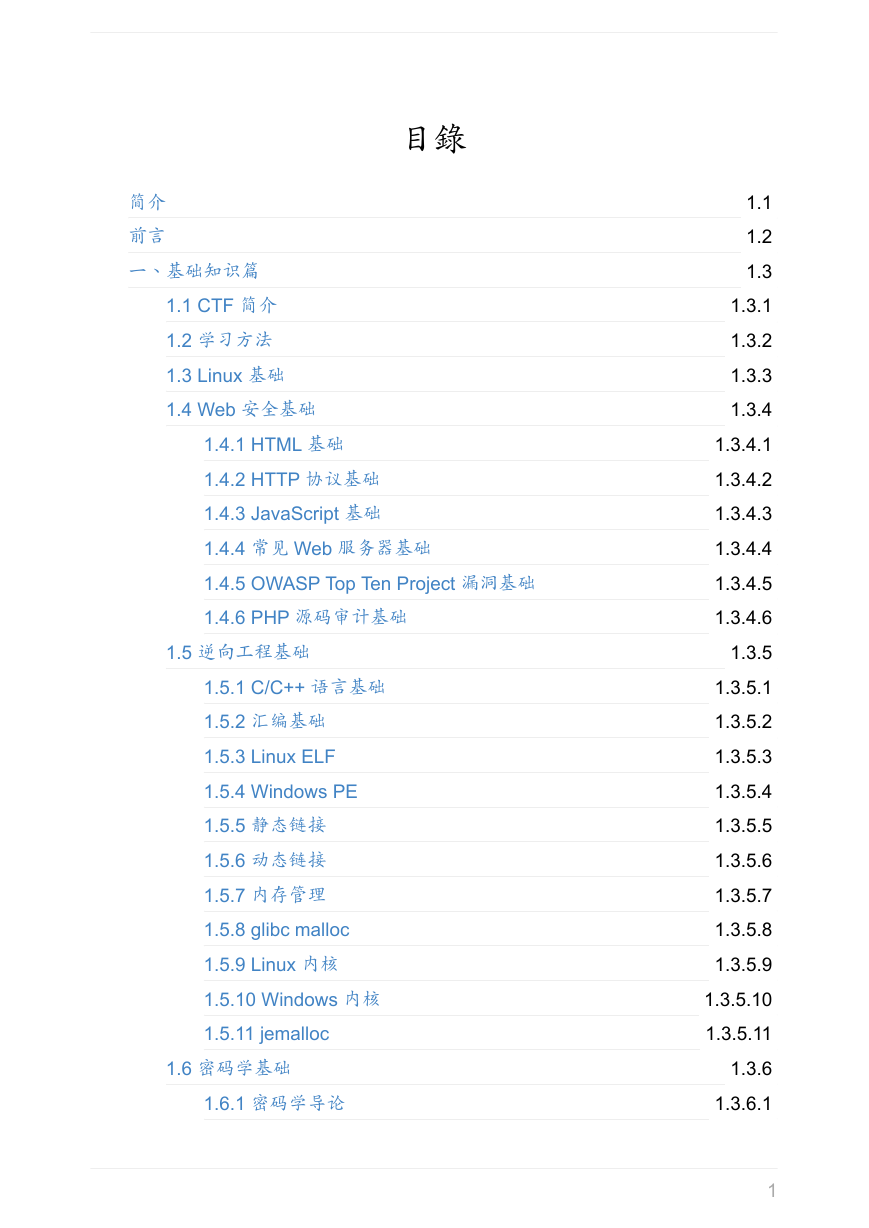
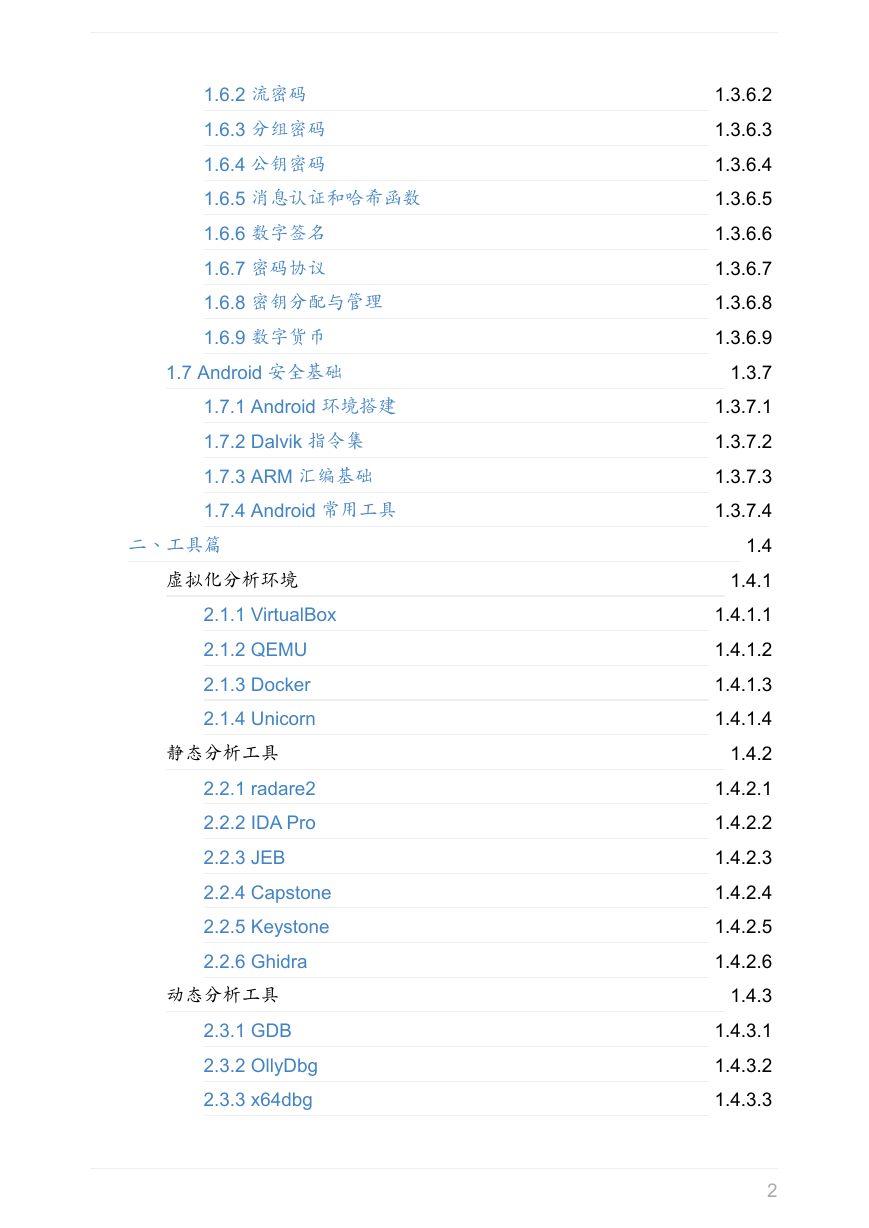



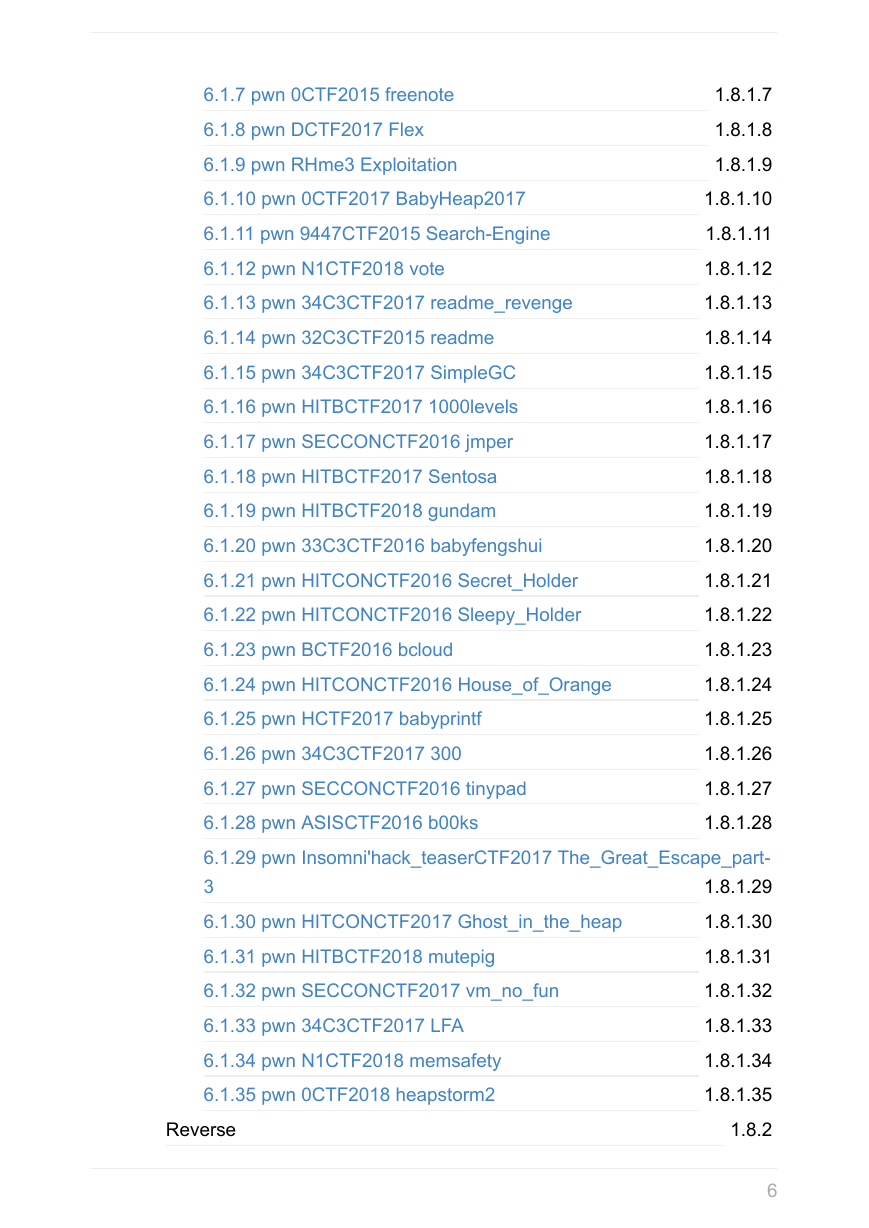
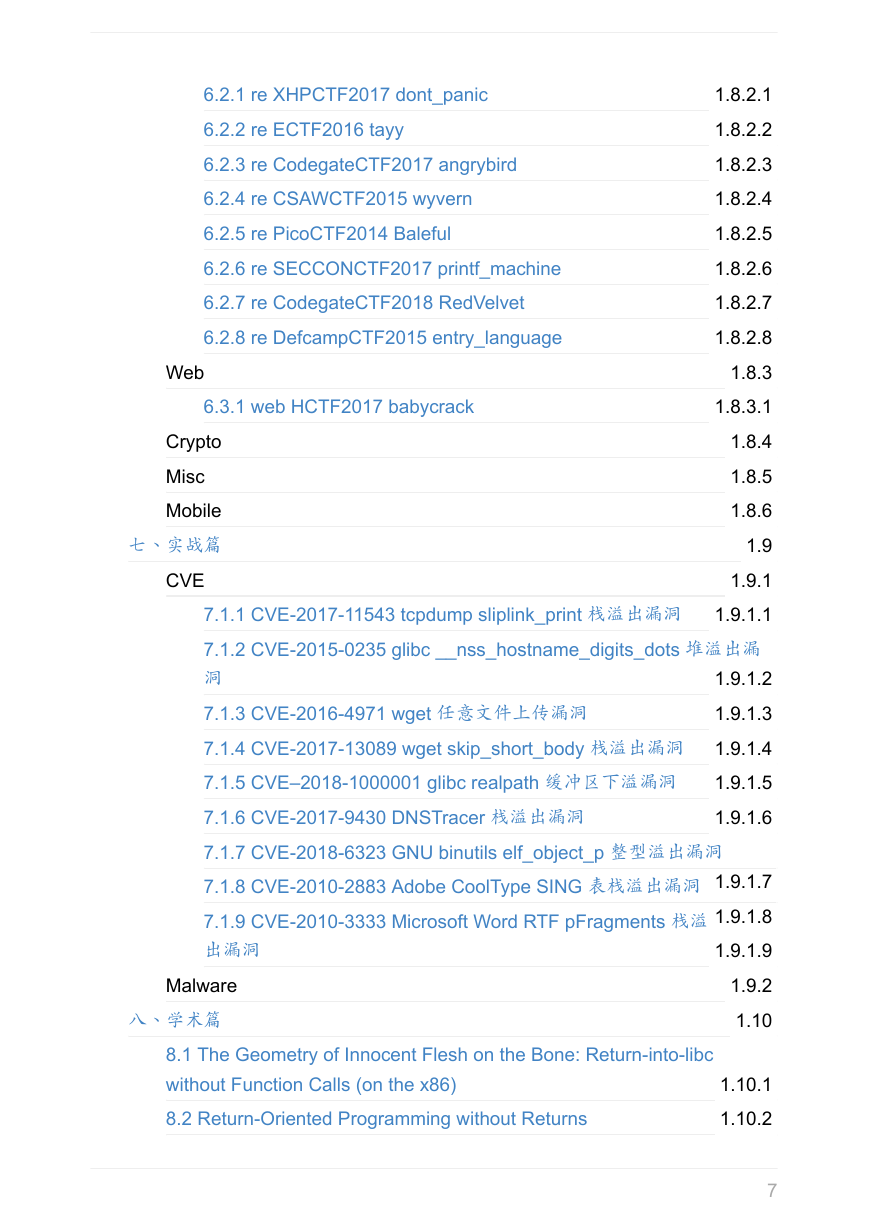
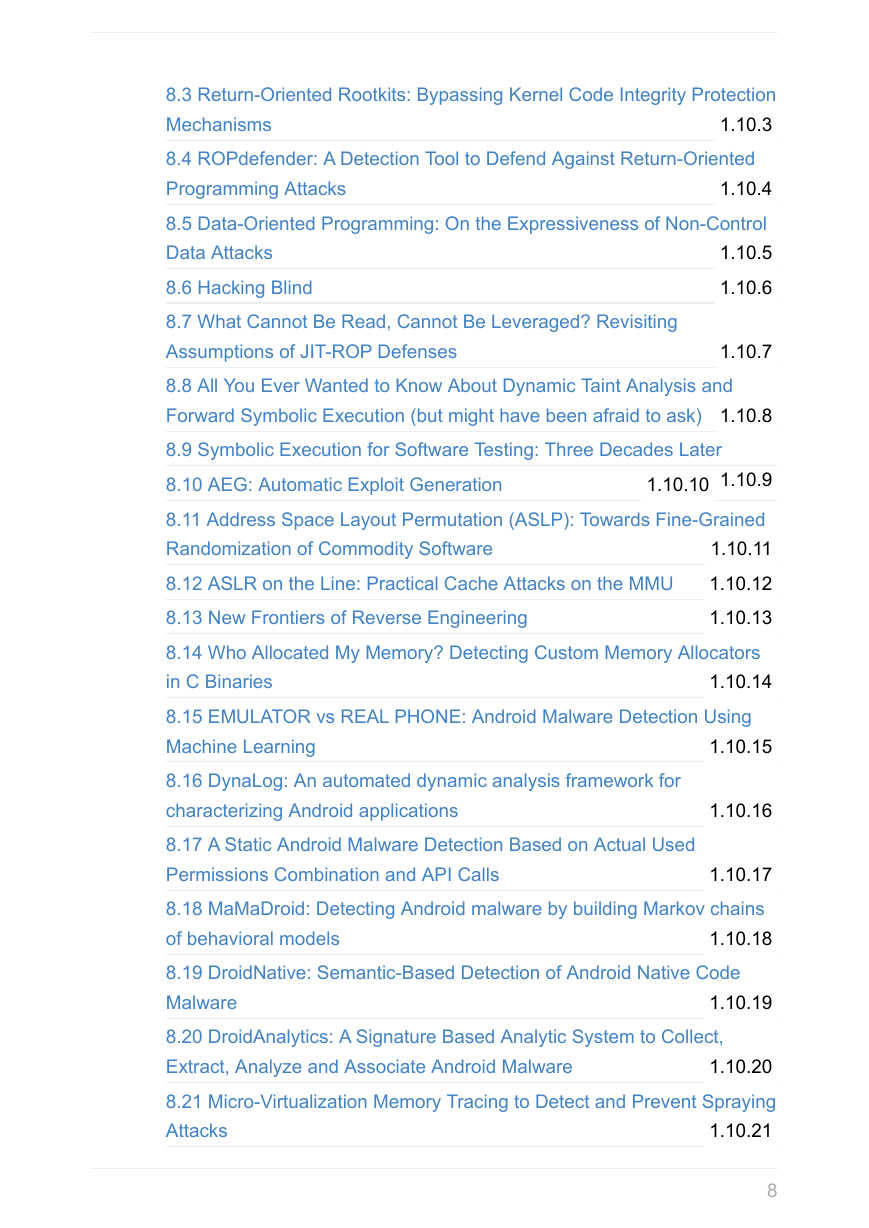








 2023年江西萍乡中考道德与法治真题及答案.doc
2023年江西萍乡中考道德与法治真题及答案.doc 2012年重庆南川中考生物真题及答案.doc
2012年重庆南川中考生物真题及答案.doc 2013年江西师范大学地理学综合及文艺理论基础考研真题.doc
2013年江西师范大学地理学综合及文艺理论基础考研真题.doc 2020年四川甘孜小升初语文真题及答案I卷.doc
2020年四川甘孜小升初语文真题及答案I卷.doc 2020年注册岩土工程师专业基础考试真题及答案.doc
2020年注册岩土工程师专业基础考试真题及答案.doc 2023-2024学年福建省厦门市九年级上学期数学月考试题及答案.doc
2023-2024学年福建省厦门市九年级上学期数学月考试题及答案.doc 2021-2022学年辽宁省沈阳市大东区九年级上学期语文期末试题及答案.doc
2021-2022学年辽宁省沈阳市大东区九年级上学期语文期末试题及答案.doc 2022-2023学年北京东城区初三第一学期物理期末试卷及答案.doc
2022-2023学年北京东城区初三第一学期物理期末试卷及答案.doc 2018上半年江西教师资格初中地理学科知识与教学能力真题及答案.doc
2018上半年江西教师资格初中地理学科知识与教学能力真题及答案.doc 2012年河北国家公务员申论考试真题及答案-省级.doc
2012年河北国家公务员申论考试真题及答案-省级.doc 2020-2021学年江苏省扬州市江都区邵樊片九年级上学期数学第一次质量检测试题及答案.doc
2020-2021学年江苏省扬州市江都区邵樊片九年级上学期数学第一次质量检测试题及答案.doc 2022下半年黑龙江教师资格证中学综合素质真题及答案.doc
2022下半年黑龙江教师资格证中学综合素质真题及答案.doc